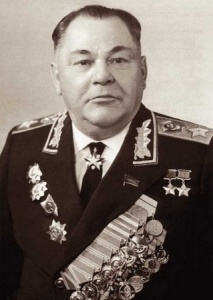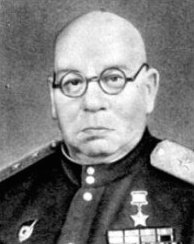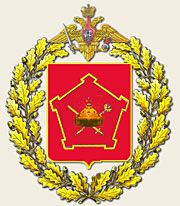
Pyotr Kirillovich Koshevoy was a Soviet military commander and a Marshal of the Soviet Union.
The cavalry corps of the Workers and Peasant Red Army was a type of military formation that existed from the early days of the Russian Civil War until 1947 when the Red Army was renamed as the Soviet Army and all cavalry corps were disbanded.
The 75th Cavalry Division was a cavalry formation of the Red Army which fought during World War II.
The 17th Rifle Division was an infantry division of the Soviet Union's Red Army during World War II.
The 57th Cavalry Division was a cavalry formation of the Red Army during the World War II.
The 32nd Cavalry Division was formed in 1938 in the Kiev Military District from the 1st Zaporozhe Cossack Cavalry Division.
The 43rd Cavalry Division was a cavalry division of the Red Army during World War II.
The 47th Cavalry Division was one of the first cavalry divisions formed after the start of the war. The unit was formed at Novocherkassk in the North Caucasus Military District from reservists and the cavalry depots in the district's cavalry training grounds.
The 52nd Cavalry Division was one of the first cavalry divisions formed after the start of the war. The unit was formed at Novocherkassk in the North Caucasus Military District likely from the reservists and cavalry depots in the district's cavalry training grounds.
The 24th Cavalry Division was a prewar division assigned to the Transcaucasus Military District on 22 June 1941. The division was assigned there after participating the Winter War.
The 31st Army was a field army of the Red Army during the Second World War.
The 119th Rifle Division was an infantry division of the Red Army, formed three times.
The 146th Rifle Division was formed for the first time as a standard Red Army rifle division in mid-1939, as part of a major build-up of the Army prior to the start of World War II. After the start of the German invasion in 1941 it defended the approaches to Kiev for several months until being surrounded and destroyed in September. A second formation began in January 1942, and the new division spent the following year on a relatively quiet sector before joining the offensives that would drive the German invaders from north-central Russia, Lithuania, and Poland. The 146th ended the war fighting in the streets of Berlin, after compiling an enviable record of service, and saw postwar duty in the Group of Soviet Forces in Germany.

The 413th Rifle Division was formed as an infantry division of the Red Army in the summer of 1941 in the Far Eastern Front. It was considered to be a "sister" division to the 415th, and was one of the divisions of Siberians sent west to help defend Moscow during the winter of 1941-42. It was assigned to the 50th Army and originally saw action in the defense of the city of Tula before going over to the counteroffensive in December, suffering massive casualties in the process. It spent much of the next year along the lines it gained over the winter, southwest of the capital, before beginning to push westward as part of Western Front's 1943 summer offensive. During the winter of 1943-44 it was in Belorussian Front gradually gaining ground towards the Dniepr River to the east of Rogachev. At the start of Operation Bagration the 413th was in the 3rd Army but was soon reassigned to the 65th Army where it remained for most of the rest of the war. The division was awarded a battle honor for its role in the liberation of Brest in July and in 1945 received both the Order of the Red Banner and the Order of Suvorov as it advanced into Poland and Germany with 2nd Belorussian Front. The 413th had a distinguished career as a combat unit, ending its combat path north of Berlin. It was disbanded in the summer of 1946.

The 325th Rifle Division was formed in September 1941, as a standard Red Army rifle division, made up of older reservists and young men with no prewar training. As with many other divisions in the 320-330 series it was flung into the fighting west of Moscow in the 10th Army to defend the capital and then to take part in the winter counteroffensive. After a year on a quiet sector the division rejoined the fighting in the late winter of 1943, eventually distinguishing itself sufficiently to be redesignated as the 90th Guards Rifle Division. After disappearing from the Soviet order of battle for more than a year a new division was formed in the spring of 1944, based on a cadre of two distinguished rifle brigades, and gave very creditable service for the duration, completing its combat path in East Prussia.

The 329th Rifle Division was first formed in September 1941, as a standard Red Army rifle division, at Voronezh. This formation was assigned to the Western Front in mid-December as the Soviet winter counter-offensive west of Moscow was developing, but had the misfortune to be cut off and destroyed behind German lines. The division was formed again nearly two years later, this time in 1st Ukrainian Front, and served with distinction with this Front during the final twelve months of the war, winning honors for its roles in the fighting in Poland, Breslau and Berlin before ending the war near Prague.

The 361st Rifle Division formed in August 1941, as a standard Red Army rifle division, at Ufa. It may be considered a "sister" division to the 363rd Rifle Division. After forming, it was assigned to the 39th Army, and played a major role in the near-encirclement of the German 9th Army around Rzhev in the winter counteroffensive of 1941-42. In recognition of its successes it was reorganized as the 21st Guards Rifle Division in March 1942. A new 361st was formed in November 1944, in the far east of the USSR. It saw action during the Soviet invasion of Manchuria in August 1945, staging several crossing operations of the Amur and Songhua Rivers during the first days of the offensive, in recognition of which one regiment was awarded the Order of the Red Banner.

The 25th Cavalry Division was a mounted division of the Red Army that served for just over a year in the Great Patriotic War. It was formed in the summer of 1941 and served in the region south and west of Leningrad during the following months against the advance of Army Group North during Operation Barbarossa. It survived a German armored counterattack before being pulled back into the reserves in September. In January 1942, it was assigned to the Mobile Group of 2nd Shock Army to take part in the Lyuban Offensive Operation. This offensive aimed to encircle and destroy the German forces besieging Leningrad; in the event, 2nd Shock was itself encircled and forced to break out as individuals and small groups from May into July. The 25th Cavalry was disbanded, and its survivors were used to help rebuild the badly depleted 19th Guards Rifle Division, while the 25th's commanding officer took over the latter division.
The 393rd Rifle Division was raised in 1941 as an infantry division of the Red Army, and served twice during the Great Patriotic War in that role. In its first formation the division followed a very similar combat path to that of the 411th Rifle Division. It was first formed on October 1 in the Kharkov Military District, probably on the basis of militia units that had been raised there. It fought in the Barvenkovo–Lozovaya Offensive that created the Izium - Barvenkovo salient in January, 1942 and was intended to play a leading role in a spring offensive aimed at the liberation of Kharkov. In the event a German counteroffensive cut off the salient; the division was deeply encircled and destroyed. In the buildup to the Soviet invasion of Manchuria a new 393rd was formed in the Far Eastern Front in late 1944. The new division fought into the northern part of the Korean peninsula, taking many ports and cities with enough distinction that it was awarded the Order of the Red Banner, and continued to serve briefly into the postwar period.

The 402nd Rifle Division was raised in 1941 as an infantry division of the Red Army, and served throughout the Great Patriotic War in that role, but saw relatively little combat. It was raised as an Azerbaijani National division in the Transcaucasus Military District and first formed part of the occupation force following the Anglo-Soviet invasion of Iran. It returned to the USSR in April, 1942, remaining in the Caucasus region until the forces of German Army Group A began its drive on the oil fields there as part of Operation Blue. In October it joined the Northern Group in the Transcaucasus Front, in the 44th Army, defending the direct route to Baku. The division took part in the counteroffensive that threw the German forces out of the Caucasus, but took heavy losses in the process. Once the German threat receded the 402nd went back to guard duties along the border with Turkey and served as a training establishment for Azeri recruits for the duration of the war.









